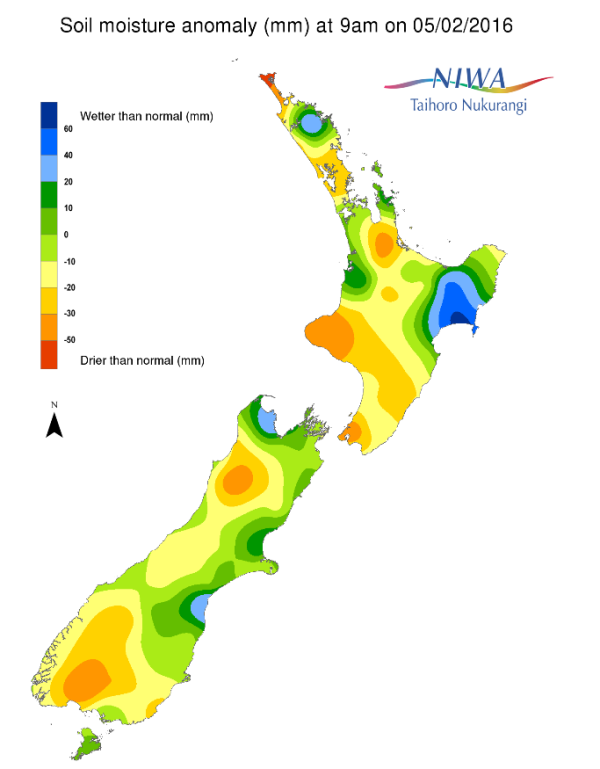A weekly update describing soil moisture across the country to help assess whether severely to extremely dry conditions are occurring or imminent. Regions experiencing these soil moisture deficits are deemed “hotspots”. Persistent hotspot regions have the potential to develop into drought.
Soil Moisture
Soil moisture levels across the North Island have generally decreased or remained the same when compared to this time last week. The most significant decreases were observed in Taranaki, far southern Hawke’s Bay, east coastal Manawatu-Whanganui, and parts of Wellington. Exceptions are across western Waikato, the coastal Bay of Plenty, and in eastern Northland, where soil moisture levels increased.
Currently, northern Northland, Auckland, central Waikato, Taranaki, Manawatu-Whanganui, southern Hawke’s Bay, and Wellington have below normal soil moisture for this time of the year. Soil moisture is near or above normal in eastern Northland, southwest and northern Waikato, much of Bay of Plenty, Gisborne, and central and northern Hawke’s Bay.
Across the South Island, soil moisture levels have decreased over the last week. The most dramatic decreases were found across interior Southland and Otago as well as the northern West Coast. Soil moisture levels remain near or above normal in pockets of mid-Canterbury and also in north coastal Tasman and Nelson. Near normal or below normal soil moisture levels for this time of the year are found elsewhere.
Outlook
Across the North Island, most places are expected to have a dry weekend. However, for some locations in the central Plateau and from Waikato through Northland, isolated showers could drop a quick 5 mm, especially during the afternoons. Widespread dry weather is expected to persist into next week, aside from isolated showers (generally <5 mm rainfall) from coastal Bay of Plenty to the Coromandel Peninsula, Auckland, and Northland.
While Tropical Cyclones Winston and Tatiana are expected to remain to the north of New Zealand early next week, a storm approaching from the south in the mid-week could absorb some moisture from the two storms. Some soaking rainfall appears possible from later Wednesday into Friday, especially for the west coast and central areas. There is a low to moderate chance for falls in excess of 25 mm. While some rainfall is possible toward the latter stages of next week, the driest weather across the North Island will probably extend from Gisborne to Wellington over the next 7 days.
After scattered rain across the south and central South Island on Friday, high pressure will result in mostly dry weather this weekend. The exception will be along the east coast, especially across mid-Canterbury, where some light rain and drizzle is possible. Falls are expected to be less than 10 mm. Fiordland will also have some wet weather on Sunday with rainfall to 10 mm possible. Sunday night into Monday, rain will spread northward along the West Coast and also affect portions of eastern Southland and southern Otago. Daily falls of 5-15 mm are possible.
Tuesday and Wednesday, rain may be moderate to heavy along the West Coast as a potentially potent storm approaches from the south and west. This storm may also have a flow of tropical moisture from one or both of the cyclones off to the north of New Zealand. Rainfall on Tuesday may range from 25-50 mm from Fiordland to the West Coast with less than 25 mm across Tasman, Nelson and western Marlborough. Rain on Wednesday and Thursday has the potential to be quite heavy across the west and north of the South Island. The potential for flooding will have to be monitored. Steady rain across these regions may slowly taper to showers toward the tail end of the week. While some rainfall is forecast to occur across the east of the South Island, amounts may be markedly less than those to the central and west. Through the next 7 days, the lowest rainfall driest will most likely be found across coastal Canterbury.
Soil Moisture
For the North Island, hotspot areas are present in extreme northern Northland, northern Auckland, and central Waikato, much of Taranaki, parts of central and southern Manawatu-Whanganui, and southern Wellington. Little in the way of organized rainfall through early next week will favour hotspot expansion across much of the North Island. Rain in the middle and latter stages of next week may work to reduce hotspot coverage, especially along the west coast, though hotspots elsewhere may remain unchanged.
Hotspot areas remain present across interior Southland and interior Otago on the South Island. New hotspots have developed along the northern West Coast, interior Canterbury, and coastal Otago over the past week. Rainfall, while minimal through the weekend, will turn out significant by the middle stages of next week across parts of the South Island. Hotspot areas should be reduced in parts of interior Southland and the West Coast, but have the potential to expand in Otago over the next week.
Background
Hotspot Watch a weekly advisory service for New Zealand media. It provides soil moisture and precipitation measurements around the country to help assess whether extremely dry conditions are imminent.
Soil moisture deficit
Soil moisture deficit is the amount of water needed to bring the soil moisture content back to field capacity, which is the maximum amount of water the soil can hold.
Soil moisture anomaly
This is the difference between the historical normal soil moisture deficit (or surplus) for a given time of year and actual soil moisture deficits.
Definitions
“Extremely” and “severely” dry soils are based on a combination of the current soil moisture status and the difference from normal soil moisture (see soil moisture maps at https://www.niwa.co.nz/climate/nz-drought-monitor/droughtindicatormaps).
Soil moisture anomaly maps
Pictured below are soil Moisture Anomaly Maps, relative to this time of year. The maps show soil moisture anomaly for the past two weeks.


